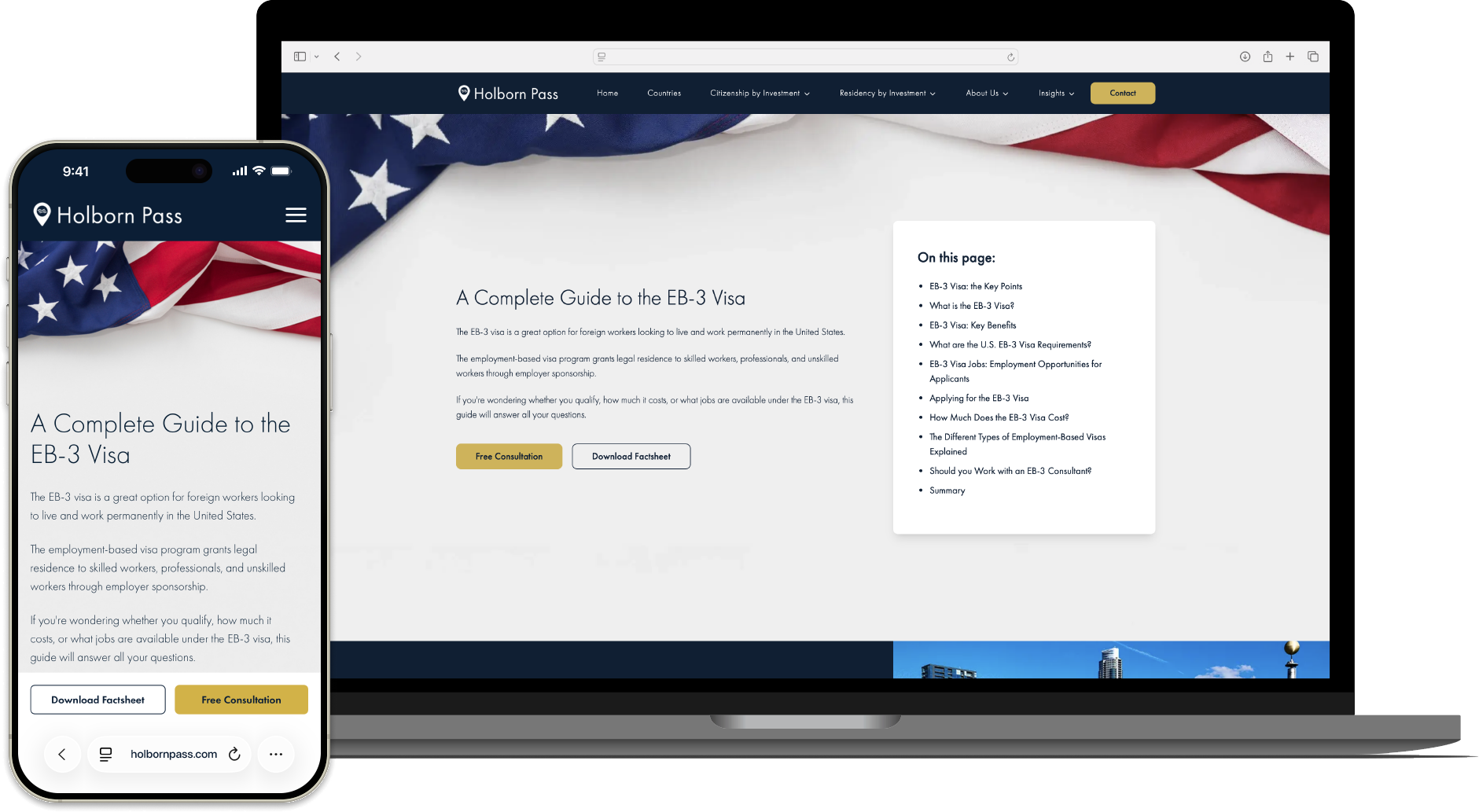
Residency by Investment
in USA
- •Obtain a U.S. Green Card
- •Live and work in the U.S.
- •Route to U.S. citizenship
Minimum Investment Amount
$45,000
Processing Time
24-36 months
Key Residency Benefit
Permanent residency in the U.S.
Why is USA a popular investment location?
The United States of America, U.S. for short, is a country of 50 states covering most of North America. It is the world's third-largest country in terms of size.
The U.S. is home to one of the most developed financial markets. And with a GDP of just over $20 trillion, the U.S. has the largest global consumer market. Widely known as the 'Land of Opportunity', the U.S. provides excellent prospects for people striving to achieve personal and professional success.
About the USA Residency by Investment programme
The EB-3 is a third preference employment-based immigrant visa. It is one of the five employment-based green card options that enables foreign nationals to live and work in the U.S. as permanent residents.
The EB-3 Visa is designed for three categories of workers; skilled workers, professionals and unskilled or other workers. Those who fall into one of these three categories may be eligible for the EB-3 Visa.
Each of the three categories is defined by the United States Citizenship and Immigration Services (USCIS) as follows:
Skilled workers: those with at least two years of experience in their chosen field of expertise.
Professionals: those with higher degrees that require a professional licence to work.
Unskilled or other workers: those who can perform jobs for which qualified workers are unavailable.
Discover the ins and outs of this route to a U.S. Green Card
Read our range of in-depth articles and get a better understanding of the EB-3 programme
What are the Benefits of Residency by Investment in USA?

A cost-effective route to U.S. residency

Visa-free travel to the U.S.

Live and work permanently in the U.S.

Grants residency for family members

Straightforward application process

Pathway to U.S. citizenship after five years

A cost-effective route to U.S. residency

Visa-free travel to the U.S.

Live and work permanently in the U.S.

Grants residency for family members

Straightforward application process

Pathway to U.S. citizenship after five years
How to obtain Residency by Investment in USA
Live the American Dream
Unlike other programmes that grant residency, there is no investment requirement.
Instead, applicants pay a total of $45,000, which is the total price for the principal applicant and includes all immigrant visa government fees. The cost for each additional applicant is $3,000. The main applicant can include their spouse and any children under the age of 21.
All costs, minus any fees, are fully refundable if the application is unsuccessful.
Key Benefit of Residency by Investment in USA
The EB-3 Visa grants successful applicants a U.S. Green Card, which provides permanent residency for the holder.
By securing a Green Card, applicants live and work in the U.S. with minimal restrictions. They also benefit from being able to leave and enter the U.S. without needing a visa, as well as live in a different state.
Successful applicants can also bring eligible family members to the U.S., including a spouse and unmarried children under 21.
Requirements are not as strict as other types of residency visas. The EB-3 is an employment-based visa, meaning you only need a non-seasonal job offer to qualify. Once issued, Green Cards have a long validity period, lasting for 10 years.
Frequently Asked Questions
USA Application Process
Receive your job offer, then apply for a Labor Certificate from the U.S. Department of Labor.
Receive your job offer, then apply for a Labor Certificate from the U.S. Department of Labor.
Await Labor Certificate approval. You'll receive a DOL case number to track your status online.
Await Labor Certificate approval. You'll receive a DOL case number to track your status online.
Apply for and complete the I-140 form
Apply for and complete the I-140 form
Pay the visa fee from the National Visa Center (NVC) and submit the DS-260 form.
Pay the visa fee from the National Visa Center (NVC) and submit the DS-260 form.
Attend a one-on-one interview at your local U.S. Consulate or Embassy.
Attend a one-on-one interview at your local U.S. Consulate or Embassy.
Receive your Green Card. You and your family must enter the U.S. within 180 days to activate residency.
Receive your Green Card. You and your family must enter the U.S. within 180 days to activate residency.
Start your new job and begin your life in the U.S.
Start your new job and begin your life in the U.S.
Which programme is right for you?
| Citizenship or Residency Programme? | No | - | - |
| Minimum Investment Amount | $45,000 | - | - |
| Minimum Stay Requirement | - | - | |
| Initial Permit Duration | - | - | |
| Time to Residence | 18-24 months | - | - |
| Time to Citizenship | 5 years | - | - |
| Family Inclusion? | Spouse, children under 21 | - | - |
| Right to Work? | Yes | - | - |
| Type of Document Received | Residency permit | - | - |
| No. of Visa-Free Countries with Passport? | 186 | - | - |

